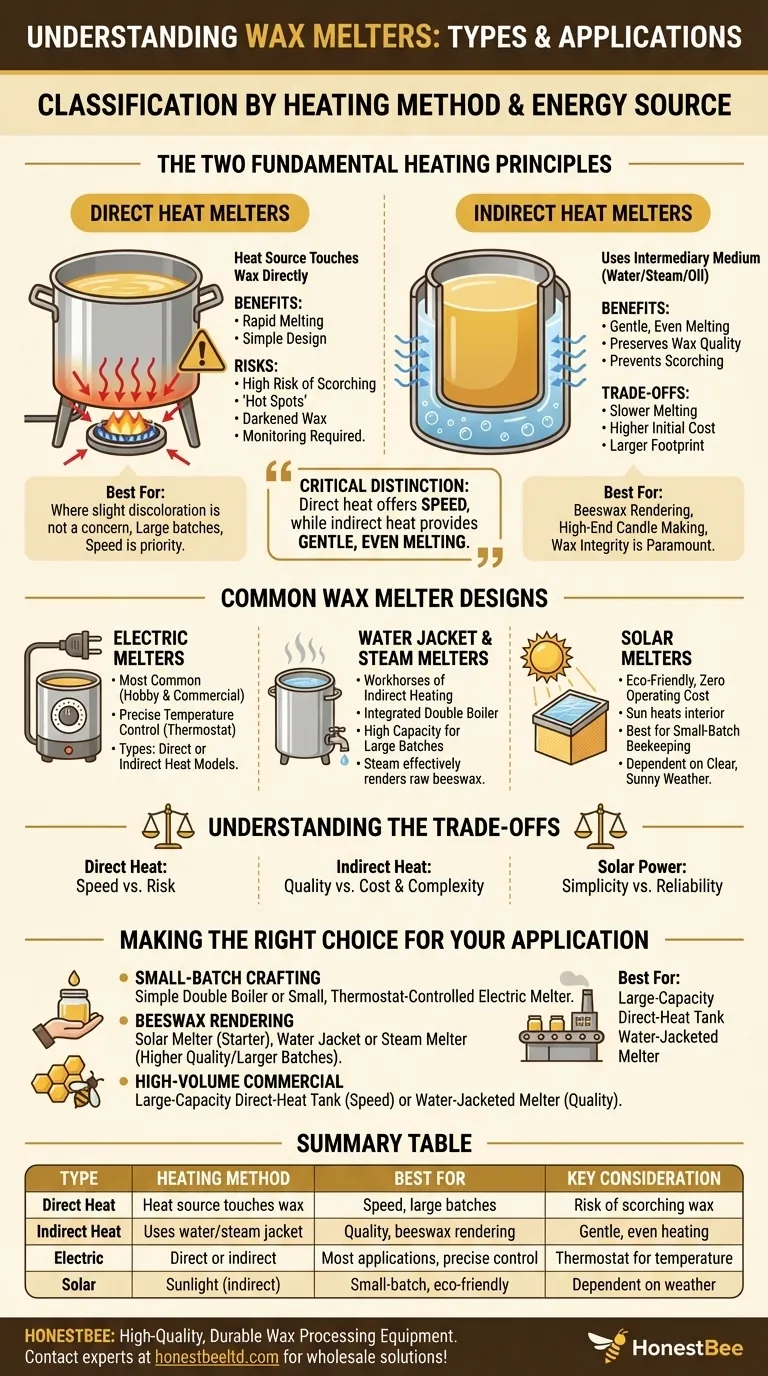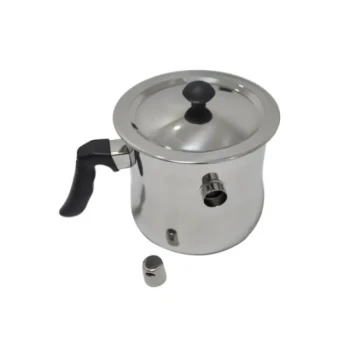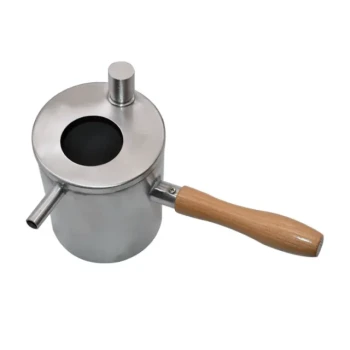At its core, a wax melter is classified by its heating method and its energy source. The primary heating methods are direct heat (where the wax touches the heat source) and indirect heat (using a medium like water or steam), while common designs are powered by electricity, steam, or solar energy.
The most critical distinction to understand is not the brand or size, but the heating principle itself. Direct heat offers speed, while indirect heat provides gentle, even melting that preserves wax quality and prevents scorching.

The Two Fundamental Heating Principles
To choose the right melter, you must first understand the two ways heat can be applied to wax. This fundamental difference impacts everything from melting speed to the final quality of the rendered wax.
Direct Heat Melters
Direct heat melters apply thermal energy straight to the surface of the melting tank. Think of a pot placed directly on a stove burner.
The heating element, whether electric or gas, is in direct contact with the metal holding the wax. This allows for very fast heat-up times.
However, this speed comes with a significant risk of creating "hot spots." These can easily scorch or burn the wax, darkening its color and potentially damaging its properties.
Indirect Heat Melters
Indirect heat melters use an intermediary medium—typically water, steam, or oil—to transfer heat to the wax. This is the principle behind a double boiler or water jacket melter.
A separate chamber or "jacket" containing the heating medium surrounds the tank holding the wax. The element heats the medium, which then gently and evenly heats the wax tank.
This method is slower but virtually eliminates the risk of scorching, resulting in a cleaner, higher-quality final product. It is the preferred method for applications where wax color and integrity are paramount, such as in beekeeping or high-end candle making.
Common Wax Melter Designs
While the heating principle is key, practical designs are often categorized by their power source or specific construction.
Electric Melters
These are the most common type for both hobbyists and commercial use due to their convenience and precise temperature control.
Electric melters can be either direct heat (fast and simple) or indirect heat (using an integrated water jacket). Their main advantage is the ability to set and maintain a specific temperature with a thermostat.
Water Jacket & Steam Melters
These are the workhorses of indirect heating. A water jacket melter is essentially an integrated double boiler, often with a large capacity for processing significant amounts of wax.
Steam melters function similarly but use injected steam to heat the wax, which can be very effective for rendering raw beeswax from honeycombs, as the steam helps separate wax from impurities.
Solar Melters
A solar melter is a simple, eco-friendly option popular among beekeepers for small-batch rendering. It's essentially an insulated box with a dark-colored metal tray and a glass or plastic lid.
Sunlight heats the interior, melting the wax, which then drains through a filter into a collection pan. While effective and cost-free to operate, its performance is entirely dependent on clear, sunny weather.
Understanding the Trade-offs
No single design is perfect for every situation. Choosing a melter requires balancing speed, quality, cost, and capacity.
Direct Heat: Speed vs. Risk
The primary advantage of direct heat is its rapid melting capability. However, this comes at the cost of constant monitoring to prevent the wax from overheating and burning. This design is best for materials where slight discoloration is not a concern.
Indirect Heat: Quality vs. Cost & Complexity
Indirect heating is the superior choice for preserving wax quality. The gentle, even heat prevents scorching and produces a cleaner final product. The trade-off is typically a higher initial cost, larger footprint, and slower melting times compared to direct heat models of similar capacity.
Solar Power: Simplicity vs. Reliability
Solar melters are brilliant for their simplicity and zero operating cost. They are an excellent choice for beekeepers with small amounts of wax cappings. Their obvious limitation is their complete reliance on strong, consistent sunlight, making them impractical for on-demand or large-scale production.
Making the Right Choice for Your Application
Your goal should dictate your choice. Consider the scale of your operation and how much you value wax quality over melting speed.
- If your primary focus is small-batch crafting or beginner candle making: A simple double boiler setup or a small, thermostat-controlled electric melter provides excellent control.
- If your primary focus is rendering clean beeswax from combs: A solar melter is a perfect starting point, while a water jacket or steam melter is the superior choice for higher quality and larger batches.
- If your primary focus is high-volume commercial production: A large-capacity, direct-heat tank (for speed) or a water-jacketed melter (for quality) is necessary.
Ultimately, selecting the right wax melter is about matching the tool's core heating principle to your specific processing needs.
Summary Table:
| Type | Heating Method | Best For | Key Consideration |
|---|---|---|---|
| Direct Heat | Heat source touches wax | Speed, large batches | Risk of scorching wax |
| Indirect Heat | Uses water/steam jacket | Quality, beeswax rendering | Gentle, even heating |
| Electric | Direct or indirect | Most applications, precise control | Thermostat for temperature |
| Solar | Sunlight (indirect) | Small-batch, eco-friendly | Dependent on weather |
Ready to choose the perfect wax melter for your apiary or business?
HONESTBEE supplies commercial beekeepers and equipment distributors with high-quality, durable wax processing equipment designed for efficiency and wax integrity. Whether you need a high-capacity water jacket melter for pristine beeswax or a reliable electric model for consistent production, we have the wholesale solution for you.
Contact our experts today to discuss your specific needs and get a quote!
Visual Guide

Related Products
- Beeswax Melter for Candle Making Honey Bee Wax Melter
- Professional Stainless Steel Wax Melter for Beekeeping and Crafts
- Steam Beeswax Melter Wax Warmer for Wax Processing
- Honey Wax Separating Wax Press with Metal Screw Wax Separator Machine
- Stainless Steel Manual Honey Press with Guard for Pressing Honey and Wax
People Also Ask
- What makes polyurethane foam environmentally friendly? The Surprising Benefits of a Durable, Inert Material
- What do you use a wax melter for? From Home Fragrance to Professional Beekeeping
- What are the primary products of honey bee farming besides honey? Discover the Hive's Hidden Treasures
- How do water jacket melters function? Achieve Gentle, Scorch-Free Melting for Sensitive Materials
- How does a steam wax melter work? A Fast, Efficient Method for High-Quality Wax



















